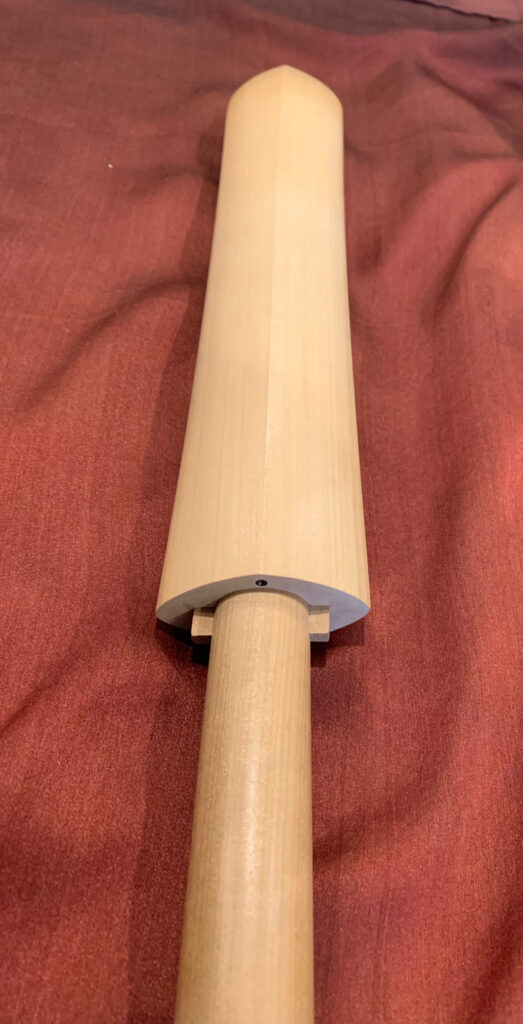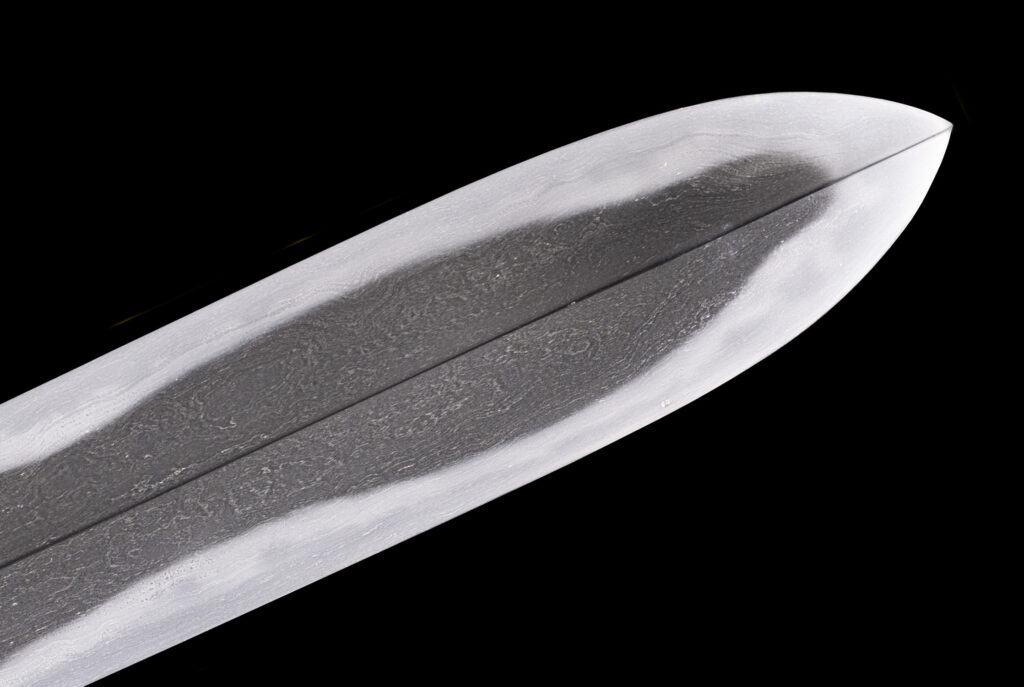Reduced!
Su-Yari by Mino Kanesaki
Skillful and Intimidating
The Mino Den is accepted as having been established with the migration of Kaneuji, and Kinju (alternately read as Kaneshige 金重) to Mino province in the closing years of the Kamakura period. The establishment of their forges there would eventually lead to a center of mass production of swords, that would only be rivaled by the Bizen region. It would grow and endure for the ensuing two and a half centuries of constant instability and near continuous warefare that Japans warlords unleashed upon the lands, culminating with the Battle of Sekigahara in 1600 AD, and then continued on to dominate Japans blade and edged tool production into the 21st century.
Kaneuji was a decendant of the Yamato school of Tegai, likely under the master smith Kanenaga. He departed Yamato, traveling to Kamakura to study with the eminent Masamune. He was perhaps the most gifted of all Masamune’s students as he was already a great mastersmith before picking up a hammer under Masamune. Kaneuji’s skill blossomed into new magnificence as a result. Kaneuji then left Kamakura for the Shizu area (thus he is know by the sobriquet of “Shizu Kaneuji”) of Mino province, bringing with him all his acquired knowledge, both Yamato and Soshu that would became the genesis of Mino Den. This fusion of the two traditions would become the foundation for hundreds of Mino swordsmiths that followed. Most prominently would be his progeny in the “Naoe Shizu” school comprised of his students that moved to Naoe, Mino, after his death.
Kaneshige, or “Kinju” as the kanji of his name are more properly read, is also listed as a student of Masamune, and is credited as a co-founder of the Mino tradition with his establishment of the Seki school. He is said to have been from Tsuruga, Echizen province and is the more enigmatic member of the Juttetsu (Ten Famoust Students of Masamune), and perhaps the one smith whose membership among them is held in the most doubt. The discourse surrounding his relationship is mostly due to the fact that among all the Juttetsu, Kinju’s education under Masamune is recorded as having been divided into two sessions, both very late in his life. His first visit is recorded as having been at the age of 61, and the second at the age of 80 or 81. Masamune would have been about half Kinju’s age, and the timelines fail to match up well for Masamune to have been of a “teacher’s” age. Exacerbating this problem is both a relatively low number of extant works, and of those, only tanto and wakizashi carry his signature. His works, while beautifully and distinctively rendered, also tend to be more sedate and unflourished than the other 9 makers. However, the influence of his work in later Mino Den works is evident, and while his tutelage under Masamune may be called into question, his impact in Mino Den is palpable. His location of Seki would become nearly synonymous with mass production swords. To this very day, Seki City remains Japans foremost center of sword, cutlery, and edged tool manufacture with a reputation similar to that of Solingen, Germany, and Toledo, Spain.
For the most part, yari were considered expendable weapons. They were manufactured by the thousands for issue to lesser skilled and/or conscripted troops. Understandably, their manufacture was more utilitarian by design. Afterall, they were being issued to the lower echelons and most would be found lying among the dead after the battle. However, there were also those yari that were skillfully and more attentively crafted yeilding both a beautiful and functional blade. This is one such piece. There were professional warriors with specialized training focused on “Sojutsu”, or “spearmanship”. These Bushi would have carried better crafted yari, commensurate with their skill and intent.
Many yari have also been conditionally compromised over the years by lack of maintenance, abuse, or through damage incurred by utilizing them as tools for other use by proxy of their length. Many were stored in their koshirae in the rafters of the roof, or hanging on walls. Fire was a real and ever-present threat in Japan, and when it broke out, it was not uncommon for lesser things to be left behind when evacuating. Furthermore, long shafted weapons such as yari, could be grabbed from the wall or rafters and used to punch or pull down burning structures and create fire breaks. There is also the scenario of soldiers in the field using their yari to stoke their campfires or skewer food on them to cook over the fire. So in many ways, yari were more at risk to losses, abuses, and damage than swords were because of their more utilitarian reputation.
This yari is signed in sanjimei “Kanesaki Saku”. There were several lineages of smiths with multiple generations by this name acitve from early-Muromachi well into the Shinshinto period. This is not all that unusual with Mino Den smiths as there were hundreds of smiths working in Mino province with massive amount of interaction between the various makers, schools, and regions. The dominant kanji in their names is “Kane” (兼) as has been the tradition of the region since at least the late Kamakura period. Shizu Kaneuji himself changed his name from the Yamato kanji form of “Kane” (包), to the aforementioned Mino form when he moved to Shizu. So the tradition to use the 兼 kanji has always been prolific. For this reason, it can be difficult to identify the exact maker in the absence of a longer, more detailed or unique mei. Perhaps shinsa may be able to better establish a more specific maker based on signature style and hallmarks of workmanship.
This yari is in excellent health and condition, and is of high quality steel and workmanship. The sugata is confident and implies eagerness. It’s construction and heat treating are exemplary of the Mino Traditions and greatly resembles the style of yakiba and hada from the Naoe Shizu school. The flowing and swirling itame holds chikei and jinie, while the yakiba is comprised of a beautifully created konie deki gunome midare hamon with kinsuji, sunagashi, and inazuma.

- Nagasa: 21.7 cm
- Kasane at Neck : 1.8 cm
- Mihaba across Edge Base: 3.2 cm
- Nakago 62.5 cm
The condition and workmanship of this yari is excellent, and the polish was clearly done by a skilled togishi as well. Polishing yari are a level up in terms of skill and specialization due to the nature of all the various angles that must be dealt with. The blade must be attentively held due to the additional cutting edges which demand extra tactile awareness and due respect. Many polishers today will refuse commissions to work on yari and especially so with the even more complex shapes such as Jumonji Yari. For those that do accept them, the charge for polishing is usually a multiple of what a sword of equal length would cost.

The high quality shirasaya is an attractive and very clear blonde honoki with a cleverly installed feature that allows the shirasaya to be well sealed. The width of the flat from edge to edge on yari stand proud of the ebu (shaft) so most shirasaya for yari and naginata will have an open space at the mouth of the saya to necessitate entry of the blade. Creating a sealed environment to protect the blade becomes an engineering problem, and we see how a well thought out and skillfully crafted solution was accomplished for this particular piece. The polish and shirasaya show that this blade was, and still is, cherished.
This yari is currently unpapered, but confidence is very high that it can be confirmed authentic at the NBTHK Hozon tier (or other organizations equivalent) if submitted. A conditional guarantee can be negotiated with sale.
I am beginning efforts to video document swords (and soon fittings also) in an effort to show the dynamics of light and how it interplays with the beauty of the steel and the features of the sword. It’s an ever evolving work in progress. Please enjoy!!
Yari of this aesthetic quality are becoming difficult to find. It is an excellent example and would be a fine addition to any collection.
Offered On Consignment: Reduced! Now $3,400.00 usd

